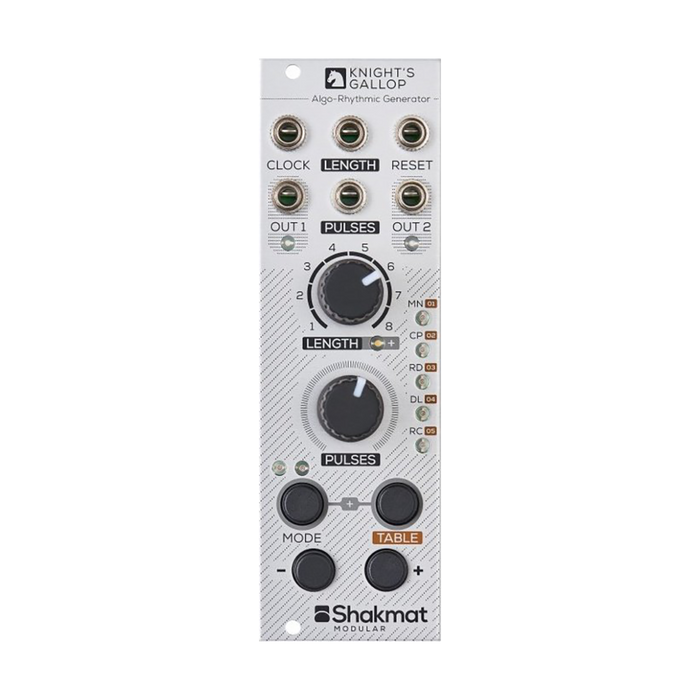
Shakmat Modular Knight's Gallop
Format: Eurorack
Width: 8HP
Depth: 25mm
Current: 22mA @ + 12V, 0mA @ -12V
Manual pdf (English)

Format: Eurorack
Width: 8HP
Depth: 25mm
Current: 22mA @ + 12V, 0mA @ -12V
Manual pdf (English)
Knight's Gallop is an 'Algo-Rhythmic' generator that provides algorithmic trigger sequences. Combining two outputs of Knight's Gallop with a table with five different tastes of rhythm patterns creates virtually limitless polyrhythms and drum fills.This module operates by receiving an external clock, and generates the main sequence referring to four parameters: Table Type, Length which sets the sequence length, Pulses which specifies the number of effective steps, and Shift which sets the playback range of the sequence. To do.
To use Knight's Gallop, first input a clock signal to the Clock input. The sequence generated by Out 1 is defined by four parameters: Table Type, Length, Pulses, and Shift.
Use the Length knob to adjust the length of the sequence in 1 to 8 steps. By pressing the Mode button and Table button at the same time, the width of the sequence length can be set from 1-8 to 9-16, and in the case of 9-16 width, the Length + LED lights up.
Use the Pulse knob to set the number of pulses in the sequence.When the knob is at its minimum, the output is muted, and as you increase the value, the number of pulses is distributed and increased in the sequence.
Each Length and Pulse parameter has its own CV input.
The Shift parameter can be adjusted with the-/ + Shift buttons. Pressing + once shifts the sequence one step forward, and pressing-shifts it one step backward.
Use the Reset input to restart the sequence from the first step.
The module has 5 tables with different tastes.At power up, the third table'Rivised Euclidean' is loaded.Press the Table button to see which table is in use. A blinking Mode & Table LED column indicates the number of the selected table.To switch between tables, hold down the Table button and use the + and-buttons.






Like Out1, Out2 also produces patterns depending on the type and length of the table, the Pulse and Shift values, but these patterns are modified by the algorithm defined by the mode you are selecting.
You can check the current mode with Mode LEDs.To switch between modes, hold down the Mode button and use the +/- buttons.Each mode has several submodes (SM), and you can switch between them by pressing the Mode button.
Main mode has four utility modes.
When Out1 is generating a sequence of length L containing a pulse of P, Out2 provides another sequence derived from the same table, but the sequence length and pulse density ratio are different. Out 2 reads a sequence of the same length as that played by Out 1 and the pulse is half the sequence.Example: Out1-P = 4 & L = 11> Out2-P = 2 & L = 11
This mode adds irregularities to Out2.
In this mode, Out1 and Out2 can be set individually.
Note that you must reach the previously set value for the knob operation to take effect.This is to prevent value skipping due to switching between submodes.This feature is indicated by a blinking Length +.Also, CV input is disabled in this mode.
In this mode, you can record the sequence using the + and-buttons.There are only two sub modes, Play and Rec.
The Pulses knob in this mode has a special operation.When the knob is turned all the way counterclockwise, the output is muted like in other modes, but the maximum clockwise value produces a roll of pulse output and a trigger for each step.This behavior can also be controlled from the Pulse CV input.